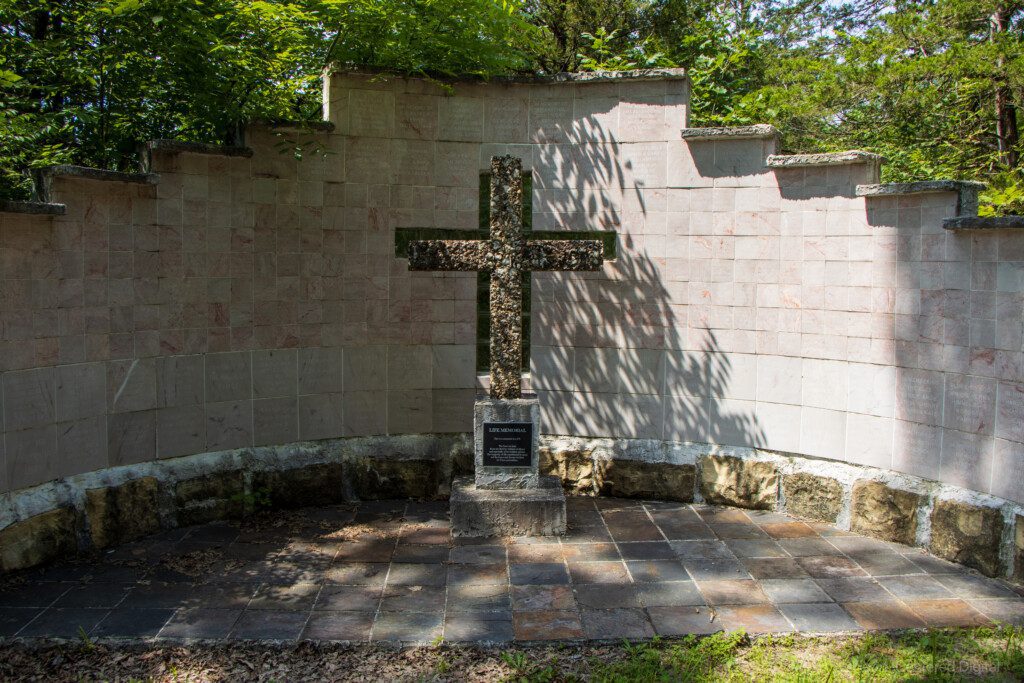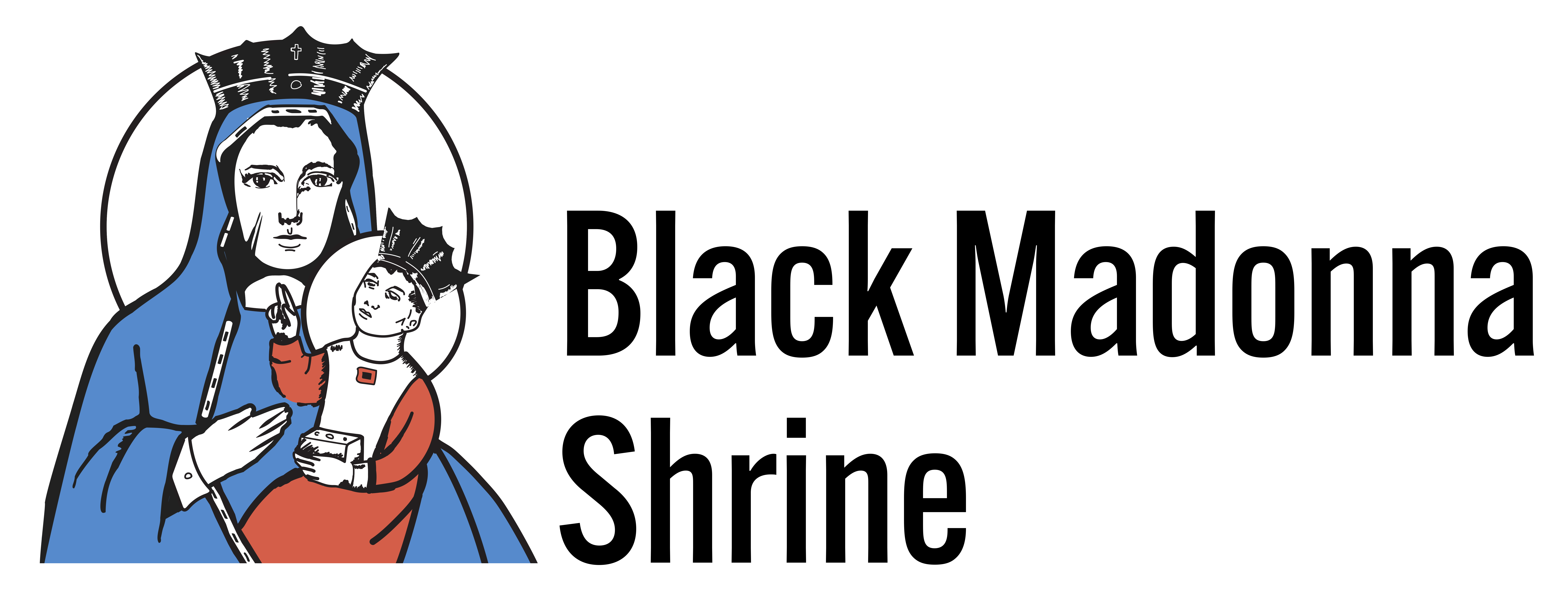Self-Guided Tours
Self-guided tours are popular with many people who visit the Shrine and Grottos individually and in small groups.
Brochures for such visits are available free of charge.
Please do not climb on the grottos or take any rock or decoration from them.
There are eight stops on the self-guided walking tour:
 As you walk on the bridge, pause and look to your left. Before you is the Crucifixion Gethsemane Grotto. The crucifix is a local landmark. During winter, hikers use it as a point of reference as they walk through the woods. Over the years, it has led many a lost soul to safety. To your right is a section of cleared land and a solitary statute. It was here in the summer of 1960 that Brother Bronislaus suffered a heat stroke. The statue represents his final project — a grotto to Our Lady of Fatima.
As you walk on the bridge, pause and look to your left. Before you is the Crucifixion Gethsemane Grotto. The crucifix is a local landmark. During winter, hikers use it as a point of reference as they walk through the woods. Over the years, it has led many a lost soul to safety. To your right is a section of cleared land and a solitary statute. It was here in the summer of 1960 that Brother Bronislaus suffered a heat stroke. The statue represents his final project — a grotto to Our Lady of Fatima.
 Porcelain birds and small animals represent the friendship St. Francis had with all creatures. The rabbits and lambs were made by pouring concrete into cupcake molds. Inscribed on the bronze tablet is the famous “Peace Prayer of St. Francis.” This prayer was so beloved by Eleanor Roosevelt and Adelai Stevenson that they instructed it be inscribed on their tombstones.
Porcelain birds and small animals represent the friendship St. Francis had with all creatures. The rabbits and lambs were made by pouring concrete into cupcake molds. Inscribed on the bronze tablet is the famous “Peace Prayer of St. Francis.” This prayer was so beloved by Eleanor Roosevelt and Adelai Stevenson that they instructed it be inscribed on their tombstones.
 Notice the use of costume jewelry in the various patterns and the colored glass set into the sides of the grotto. When light passes through the jars, a stream of colored light would shine forth. The flower pots contain “flowers” that were once the light fixtures for the old monastery. Continuing up the stairs, you reach a flower garden with a statue of a boy playing with a dog. This was Brother Bronislaus’ favorite statue. Perhaps it reminded him of his youth.
Notice the use of costume jewelry in the various patterns and the colored glass set into the sides of the grotto. When light passes through the jars, a stream of colored light would shine forth. The flower pots contain “flowers” that were once the light fixtures for the old monastery. Continuing up the stairs, you reach a flower garden with a statue of a boy playing with a dog. This was Brother Bronislaus’ favorite statue. Perhaps it reminded him of his youth.
 These flower pots were constructed from Jell-O molds, laying one on top of the other. Some of the flowers were made from paper cupcake molds.
These flower pots were constructed from Jell-O molds, laying one on top of the other. Some of the flowers were made from paper cupcake molds.
It was here that Brother Bronislaus passed away. He had been sick with the Asian flu, and hadn’t fully recovered his strength when he returned to his work. On August 12, 1960, he was overcome by the summer sun. Leaving a trail of tools from the Fatima statue, he made his way to this grotto. His body was discovered by members of the community. They knew something was amiss when the failed to arrive for evening prayers.
 The Mount of Olives, where Our Lord and Savior pleaded, “Can you not pray with me for even just one hour?” While Jesus agonized in the garden, Peter, James and John slept. In this grotto, colored jars were used again to enhance the decoration. When it was first built, the jars would filter sunlight and illuminate the sleeping apostles.
The Mount of Olives, where Our Lord and Savior pleaded, “Can you not pray with me for even just one hour?” While Jesus agonized in the garden, Peter, James and John slept. In this grotto, colored jars were used again to enhance the decoration. When it was first built, the jars would filter sunlight and illuminate the sleeping apostles.
 You have now come to the first grotto built by Brother Bronislaus. A perfectionist, he worked on this grotto for years — tearing it down and rebuilding it several times. Though not as ornate as the other grottos, it has some fascinating features. The white altar stone is from the original monastery chapel. Prior to the present statue, a picture was placed there. A deposit box with a coin drop can be found built into the base of the grotto. Donations were made for lighting small vigil candles at the base. The statue of St. Francis reaching up to Christ Crucified is called the “Vision of St. Francis.” Vandals smashed the glass and stole the statue that Brother Bronislaus had set there. The current statue was donated in 1997.
You have now come to the first grotto built by Brother Bronislaus. A perfectionist, he worked on this grotto for years — tearing it down and rebuilding it several times. Though not as ornate as the other grottos, it has some fascinating features. The white altar stone is from the original monastery chapel. Prior to the present statue, a picture was placed there. A deposit box with a coin drop can be found built into the base of the grotto. Donations were made for lighting small vigil candles at the base. The statue of St. Francis reaching up to Christ Crucified is called the “Vision of St. Francis.” Vandals smashed the glass and stole the statue that Brother Bronislaus had set there. The current statue was donated in 1997.

 As you continue on your tour, look at how the wall ends and how bushes begin. The wall once stretched all the way across, ending at a gateway pillar. In the late 1960s, a drunken driver lost control of his car and plowed into the wall. The damage was irreparable, and it was decided to plant bushes to cover signs of the destruction.
As you continue on your tour, look at how the wall ends and how bushes begin. The wall once stretched all the way across, ending at a gateway pillar. In the late 1960s, a drunken driver lost control of his car and plowed into the wall. The damage was irreparable, and it was decided to plant bushes to cover signs of the destruction.

 Turning to your right, you will continue to the Assumption grotto. The pathway is lined with six small grottos. These represent the Seven Joys of the Blessed Virgin, also known as the Franciscan Crown Rosary. The first is The Annunciation, second The Visitation, third The Birth of Our Lord, fourth The Adoration of Jesus by the Magi, fifth The Finding of Jesus in the Temple, and sixth Resurrection of Our Lord. These smaller grottos culminate in the Assumption Grotto, which is Stop 7a on your tour.
Turning to your right, you will continue to the Assumption grotto. The pathway is lined with six small grottos. These represent the Seven Joys of the Blessed Virgin, also known as the Franciscan Crown Rosary. The first is The Annunciation, second The Visitation, third The Birth of Our Lord, fourth The Adoration of Jesus by the Magi, fifth The Finding of Jesus in the Temple, and sixth Resurrection of Our Lord. These smaller grottos culminate in the Assumption Grotto, which is Stop 7a on your tour.
 With six smaller grottos leading to it, the Assumption grotto represents The Assumption of Mary into Heaven. This is the largest of the grottos on the property, and it marks the former entrance to “The Way of the Cross,” a two-mile trek through the woods. Descending the hill, you are invited to cross over the grass to the Crucifixion Outlook.
With six smaller grottos leading to it, the Assumption grotto represents The Assumption of Mary into Heaven. This is the largest of the grottos on the property, and it marks the former entrance to “The Way of the Cross,” a two-mile trek through the woods. Descending the hill, you are invited to cross over the grass to the Crucifixion Outlook.
 Following the path, you will come to the only natural grotto on the property. It has been enhanced by the creativity of Brother Bronislaus. This is a favorite of many visitors and, during the Christmas season, pilgrims have been known to offer gifts, just like the Magi.
Following the path, you will come to the only natural grotto on the property. It has been enhanced by the creativity of Brother Bronislaus. This is a favorite of many visitors and, during the Christmas season, pilgrims have been known to offer gifts, just like the Magi.

As you return to the chapel, you are passing the Life Memorial, which was constructed to deal with erosion and safety concerns. Further information is available in the gift shop. The three bells before you are the last bells struck by the Stuckstede Bell Company. The foundation on which they rest is from the old bell tower that stood next to the Cedar Wood Chapel. The bell tower was saved from fire, only to be torn down after years of decay.
You are invited to stay and meditate in the Chapel or enjoy a picnic lunch in the pavilion.
Other Grottos and Sites
Around the Chapel and parking lot are the 14 Stations of the Cross, statues of St. Anthony, the Sacred Heart of Jesus, Our Lady of Grace and, behind the gift shop, there is a statue of Our Lady of Czestochowa.
The Black Madonna Shrine and Grottos are part of the 300-acre Franciscan Mission. Please keep in mind that some are open to the public and others are not.

Also located on this property are:
St. Joseph’s Hill — A former nursing home operated by the Brothers. (closed to the public)
Stone Cottage — original (closed to the public)
Our Lady of the Angels Monastery — Where some of the Brothers reside. (closed to the public)
Sacred Heart Chapel (closed to the public)
The Cemetery — Located forward left of the gazebo.
Crucifixion Grotto — Situated between the Stone Cottage and St. Joseph Hill
St. Francis Grotto — A second grotto named for the Brothers’ patron Saint
